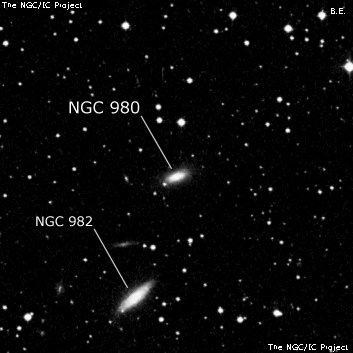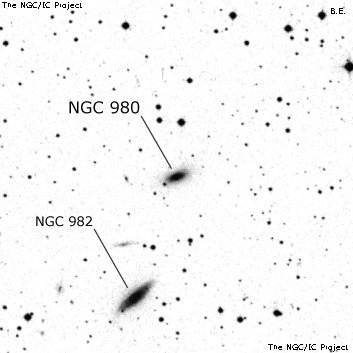NGC/IC Project Restoration Effort
(This is a very very beta version)
NGC980


Basic Information
Location and Magnitude
Right Ascension: 2:35:18.5
Declination: +40:55:37
Constellation: AND
Visual Magnitude: 13.0
Historic Information
Discoverer: Herschel W.
Year of discovery: 1786
Discovery aperture: 18.7
Observational
Summary description: vF, pS, sp of 2
Sub-type: S0
Corwin's Notes
=====
NGC 980 and NGC 982. William Herschel found these two nebulae, but did not
measure individual positions; his position is "between them." Thus, it is
John Herschel's positions that are used in the GC and NGC. Unfortunately, JH
did not carry over into the GC his uncertainty in the position of H III 572 =
h 235; this is noted in his 1833 catalogue (RA and NPD): "02 24 40.5:, 49 55
25:". The other nebula, H III 573 = h 235 carries no such uncertainty
symbols: "02 24 44.8, 49 52 39." If this latter position is precessed to
1950, it agrees closely with those measured by Bigourdan and by Dressel and
Condon for "NGC 980." Dressel and Condon, of course, simply copied the
designation from UGC. Bigourdan gives no reason for his identifications,
simply noting that "NGC 982" is fainter than "NGC 980." The MCG, however,
calls this southeastern object "NGC 982," apparently preferring to believe
that the NGC declination is incorrect rather than the right ascension.
Who's right?
Let's look back at John Herschel's observations since that is where the
incorrect position comes from. If we precess his uncertain position for the
western object, we find that the RA but not the declination agrees with that
from the modern observations. So, the two galaxies are oriented northwest-
southeast on the sky, but the NGC positions (from Sir John) say southwest-
northeast. Indeed, the GC and NGC descriptions state this orientation
explicitly.
However, Dreyer has a note in the NGC repeating part of Sir John's original
description for h 235: "Dist. 3 arcmin; pos from the next one = 337.0 deg,"
and adding, "Is the p one perhaps the most northern? H says nothing about
their relative position; not observed by d'A." John Herschel's note about
the position angle between the two being 337 deg is the vital clue here,
since it suggests that the nw/se orientation is correct.
Let's now take the position of h 236 as correct -- as indeed it is within the
known statistical errors of Sir John's observations (about 2 arcmin). Now,
assume that Sir John measured the position of h 235 with respect to h 236,
perhaps by measuring the distance and position angle that he quotes. This
would then imply that he made an error in calculating the offset in
declination. If this is true, then changing the sign of the declination
offset (2 arcmin 46 arcsec) would put the declination exactly on the true
declination: +40 42.5 for 1950 (NPD = 49 49 53 for 1830).
So, here is another case where the position for a nebula was measured with
respect to another nearby nebula, which in turn was referred to the
"fundamental" reference system (see the note on NGC 2424 and 2427 for
another instance of this). So, I think that the declination of NGC 980 is out
by 5.5 arcmin, that the UGC identifications are switched, and that the MCG got
them right.
Another minor mystery: in the GC, JH has the distance as "210 arcsec" rather
than "3 arcmin". This makes his observation closer to the true distance on
the sky. I suspect that it comes from his original observing records -- but
why didn't he use it in his 1833 list?
Steve's Notes
=====
NGC 980
17.5" (11/27/92): faint, fairly small, elongated 5:2 WNW-ESE, small bright core, similar appearance but slightly fainter by 0.5 mag than NGC 982 3.5' S. Identifications of NGC 980/NGC 982 reversed in the RNGC, UGC, CGCG.



